freedompyro
holmes1880
Posts: 116
Registered: 16-6-2011
Member Is Offline
Mood: No Mood
|
|
Oxygen Balance of Charcoal and Carbon Black?
The oxygen balance of Carbon is -266.7% according to the standard explosives formula for calculating OB.
http://en.wikipedia.org/wiki/Oxygen_balance
Now, I have searched and searched and I can't verify the oxygen balance of Charcoal or Carbon Black. I don't even think its possible to calculate
exactly for charcoal, just approximately. There are so many different oils and resins inside wood and their percentages will vary depending upon how
hot the charcoal was cooked and what type of wood was used.
What I am looking for is a standard approximate. Anyone ever found it in any manufacturing papers or patents?
I was thinking of reverse engineering it off of the black powder formula, however I am not sure black powder is perfectly oxygen balanced.
Also, is carbon black(lampblack) 100% carbon or is it some sort of mix of carbon and a bunch of petroleum burning byproducts?
Edit: I reverse engineered the black powder formula and calculated that Charcoal has a approx OB of -174%. I just need carbon black now. Can anyone
verify this?
KNO3 (+47.5%) OB
Sulfur (-100%) OB
Charcoal (?) OB
Black Powder (Optimal Formula)
Potassium nitrate 74.6
Charcoal (Airfloat) 13.5
Sulfur 11.9
So, this would be...
KNO3/C/S 74.6/13.5/11.9
Solving for Oxygen Balance Charcoal as Carbon equivalent
47.5 * 0.746 - 266.7 * 0.135 - 100 * 0.119
35.435 - 36 - 11.9
Oxygen Balance is -12.465
Now, we know that Charcoal is not equivalent to Carbon and that black powder formula is pretty much accurate... So, let us solve what OB Charcoal
actually is!
Lets reverse engineer for Charcoal OB by changing Charcoal OB until result OB is zero.
First less take KNO3 minus Sulfur from the results of the calculation above... That gives us 25.535.
Now we know our target number for charcoal.
So, what times 0.135 = 23.535? 174!
Final result... We shall say that charcoal has an approximate oxygen balance of -174.
Lets just calculate out to verify...
Optimal Black Powder Formula
47.5 * 0.746 - 174 * 0.135 - 100 * 0.119
35.435 - 23.49 - 11.9
Oxygen Balance is +0.045% (Close enough!)
[Edited on 24-12-2011 by freedompyro]
|
|
|
hissingnoise
International Hazard
    
Posts: 3940
Registered: 26-12-2002
Member Is Offline
Mood: Pulverulescent!
|
|
The 6-1-1 formula has long been found to have the most vigour but it's as much a 'dark art' as it is science.
Lamp-black is believed to contain, among other complex molecules, small quantities of various fullerenes.
And different fuels would give slightly different compositions!
|
|
|
Maniak
Harmless

Posts: 45
Registered: 26-6-2004
Member Is Offline
Mood: No Mood
|
|
Why you need oxygen balance of charcoal? Pyrotechnic mixtures are too complex to be designed via simple oxygen balance counting, they are much more
about experiments and art..
The main field of use of oxygen balance is in mining explosives for optimizing its terminal gas composition. There isn't any straightforward
dependence of OB on power nor detonation characteristics in explosives. With pyrotechnics it is even more difficult to calculate something reasonable.
I tried to find out elemental composition of charcoal:
http://www.biochar-international.org/images/Evans_SSSACharco...
there is an example presentation where they state some sort of charcoal consist of 76% C + 4,3% H + 19% O + 0,7% ash => OB = -218
Using different temperatures, carbon percentage may vary from 50 to 90% so the oxygen balance interval may be really wide.
|
|
|
Rosco Bodine
Banned
Posts: 6370
Registered: 29-9-2004
Member Is Offline
Mood: analytical
|
|
The form of carbon can definitely affect the burn rate of pyrotechnic compositions. Slowing the burn rate for fuse powder by half to a third the rate
of charcoal based powder can be done by using the denser carbon gotten from carbonizing sugar substituted for charcoal in the composition analogous to
ordinary gunpowder. See US2415848 attached.
Attachment: US2415848 Slow Burning Fuse Powder.pdf (92kB)
This file has been downloaded 541 times
|
|
|
freedompyro
holmes1880
Posts: 116
Registered: 16-6-2011
Member Is Offline
Mood: No Mood
|
|
Good stuff Rosco. Can sugar charcoal be prepared the same way as wood via heating inside a enclosed vessel so no oxygen can get in? I assume the same
method works as well.
|
|
|
Rosco Bodine
Banned
Posts: 6370
Registered: 29-9-2004
Member Is Offline
Mood: analytical
|
|
How exactly is best to do this I'm not sure. Charring sugar to carbon by dehydration with sulfuric acid should do the trick. Afterwards crushing the
carbon and rinsing it with water, ammonia, and then water again followed by drying ought to leave the pure carbon.
|
|
|
hissingnoise
International Hazard
    
Posts: 3940
Registered: 26-12-2002
Member Is Offline
Mood: Pulverulescent!
|
|
Yes, sugar carbin is vert pure but it dosen't have charcoals gtrae porosity and this makes it less suitable for inclusoin in gun powder
|
|
|
Neil
National Hazard
   
Posts: 556
Registered: 19-3-2008
Member Is Offline
Mood: No Mood
|
|
Great link Rosco thanks.
| Quote: |
Yes, sugar carbin is vert pure but it dosen't have charcoals gtrae porosity and this makes it less suitable for inclusoin in gun powder
|
Some ones been fermenting their sugar.. 
|
|
|
Rosco Bodine
Banned
Posts: 6370
Registered: 29-9-2004
Member Is Offline
Mood: analytical
|
|
translation needed German to English
Here's a German patent DE487026 which describes production of a dense carbon from sugar using sulfuric acid.
This is probably describing what I was thinking about is probably the easiest and most direct chemical method for obtaining a dense carbon. It is
referenced in US2036380 which describes an opposite sort of porous material resulting from dehydration using HCl to produce and intermediate and then
pyrolysis under extereme conditions. An idea I had which may be worth an experiment is to react TCCA with sugar under conditions as would chlorinate
the sugar would instead perhaps simply char it to carbon with HCl being produced as a byproduct, this simply being off the top of my head as a
possibility and I have not even written the reaction to see if this really makes any sense  ....it is simply a guess such a result may possibly happen. Another possibility is that DMSO might be used as a solvent with some H2SO4
as a catalytic, regenerable dessicant and the ....it is simply a guess such a result may possibly happen. Another possibility is that DMSO might be used as a solvent with some H2SO4
as a catalytic, regenerable dessicant and the
sugar may be carbonized on refluxing, with the H2O from dehydration being azeotroped from the mixture.
One issue that may arise with a slow burning time fuse gunpowder made using dense carbon is difficulty of ignition.
Such a powder might need to be primed with a fast powder which takes fire easily to ensure reliable ignition. Match compositions, sparkler
compositions, spolettes, and visco or time fuse could be applications for a slow burning black powder.
Attachment: DE487026 Dehydration of Sugar to Carbon.pdf (141kB)
This file has been downloaded 498 times
Attachment: US2036380 Adsorbent Carbon from Sucrose.pdf (287kB)
This file has been downloaded 469 times
|
|
|
Rosco Bodine
Banned
Posts: 6370
Registered: 29-9-2004
Member Is Offline
Mood: analytical
|
|
Here is probably the most elegant approach
http://www.youtube.com/watch?gl=SG&feature=related&h...
Attached is an article "Processing of sucrose to low density carbon foams" which provides more information.
[Edited on 26-12-2011 by Rosco Bodine]
Attachment: Processing of sucrose to low density carbon foams.pdf (384kB)
This file has been downloaded 1341 times
|
|
|
Hennig Brand
International Hazard
    
Posts: 1284
Registered: 7-6-2009
Member Is Offline
Mood: No Mood
|
|
I have been using sugar carbon for a while now, for producing fuses, and I find it to be much superior for this purpose than any of the wood
charcoals I have tried. Most of the main reasons why it is superior, that I know of, are in that patent Rosco posted above. For one, it is much less
reactive than wood charcoal, being almost exclusively composed of carbon and lacking the cell walls of wood charcoal.
Anyway, here are a few pictures of some sugar charcoal being made last week. Notice that the tin (steel) can is only filled 1/5 to 1/4 full otherwise
when it melts and foams up, before carbonizing, it will overflow and make a big mess. The "retort" is made from two old soup cans. I had to go around
the edge of the top can (the male part) with a hammer so that they would fit together. It is an extremely cheap way of making a charcoal maker. I have
made really big ones too out of large juice cans (for making wood charcoal).
The can was set into a wood fireplace on a bed of coals, out of convenience, and heated until all the volatiles were driven off. The can was next
taken out of the fireplace and allowed to cool before opening. It is much easier to reduce the particle size of sugar carbon than it is to reduce the
particle size of wood charcoal.
I had been using sugar in my fuses, which did give a nice slow burning fuse but it was cooler burning, didn't burn through small openings as well and
didn't ignite harder to ignite compositions as well. Sugar is also hygroscopic, which is not ideal in a fuse.
You can see that when sugar burns there is a lot of water produced. This was the main source of my problems.
C6H12O6(s) + 6O2(g) -----> 6CO2(g) + 6H2O(g)
Vaporizing the water takes a lot of energy away from that produced in the combustion reaction.
Sugar carbon solves the hygroscopicity problem also. Unlike sugar, sugar carbon is not hygroscopic.
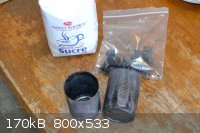 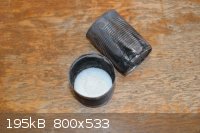 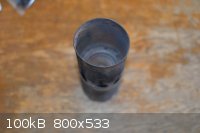 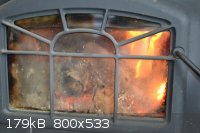 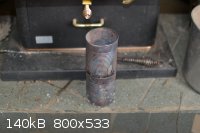 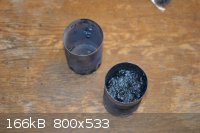 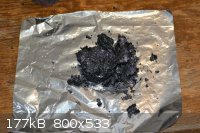
[Edited on 15-3-2013 by Hennig Brand]
"A risk-free world is a very dull world, one from which we are apt to learn little of consequence." -Geerat Vermeij
|
|
|
Hennig Brand
International Hazard
    
Posts: 1284
Registered: 7-6-2009
Member Is Offline
Mood: No Mood
|
|
I guess how much heat a material produces when burned is complicated and has to with things other than just the composition. Thought I'd compare
carbon to sucrose (table sugar).
Carbon Heat of Combustion approximately 32.8 kJ/g
Sucrose Heat of Cumbustion approximately 16.4 kJ/g
When carbon is burned it releases about twice the energy that sucrose does per gram. Sugar tends to clump, liquify/harden, (recrystallize?), etc with
changing humity, none of which are desirable qualities. Carbon burns hot and is very storage stable in most mixtures.
I guess when sucrose is burned the water is formed in the vapor phase, so my above statement about vaporizing water is most likely off. Probably its
water vapor's higher heat capacity than air and the other gases involved which results in a cooler flame/fuse. Oh, and of course the fact that half
the energy is produced to begin with (per gram) relative to carbon.
[Edited on 17-3-2013 by Hennig Brand]
"A risk-free world is a very dull world, one from which we are apt to learn little of consequence." -Geerat Vermeij
|
|
|
Hennig Brand
International Hazard
    
Posts: 1284
Registered: 7-6-2009
Member Is Offline
Mood: No Mood
|
|
I just wanted to clarify something from the last post. The values for heat of combustion provided are higher heating values (HHV) and what should have
been shown are lower heating values (LHV).
Higher heating values are determined by bringing all the products of combustion back to the pre-combustion temperature. The gas of by far greatest
significance is water vapor, as when it is cooled there is a phase change and the release of a huge amount of energy compared to what would be
released by cooling the other combustion, non-condensing gases. The higher heating value is what would be obtained from a bomb calorimeter test, as
all the water vapor from combustion is condensed and the energy collected in the surrounding water. Lower heating values do not include the latent
heat of vaporization from condensation of the water vapor produced during combustion.
Lower heating values are a more accurate value to use, for most combustion type reactions, since usually the water vapor is expelled before it
condenses and the energy associated with condensation is not collected.
Since there is no water vapor produced when carbon is burned the LHV for carbon is practically the same as the HHV. For sucrose however there is a
significant drop, from HHV to LHV, because of the water produced.
.............HHV (kJ/g)............LHV(kJ/g)
Carbon.....32.8....................~32.8
Sucrose....16.4.....................~15
This shows that sucrose is actually worse than previously shown. Sucrose has less than half the effective heat of combustion of carbon. I really like
sugar carbon.
I use only KNO3 and sugar carbon in my fuses. I may find later that sulfur should be added, but sulfur has a really low heat of combustion (LHV = 9.16
kJ/g). Using sulfur would lower the flame temperature. I find the flame propagates quite well even without the sulfur and I kind of like the fact that
my fuses are a little harder to ignite.
"A risk-free world is a very dull world, one from which we are apt to learn little of consequence." -Geerat Vermeij
|
|
|